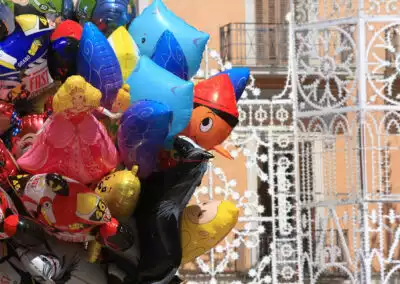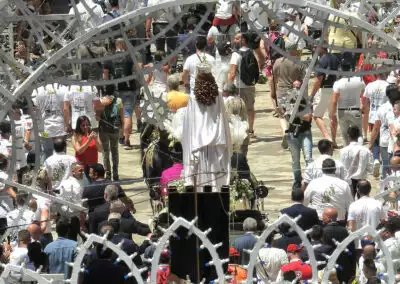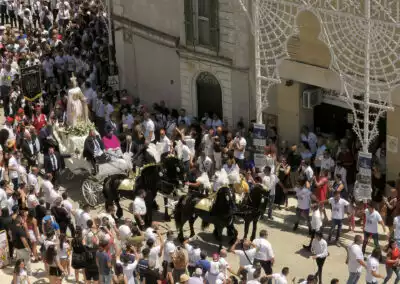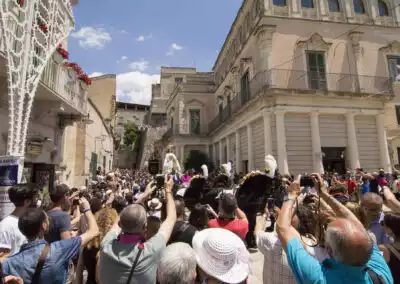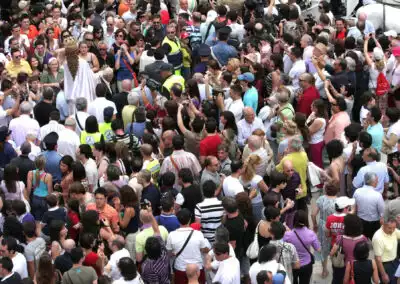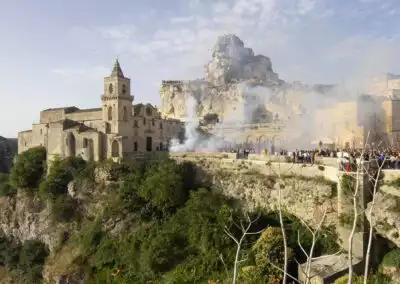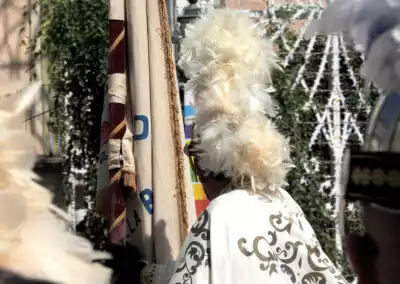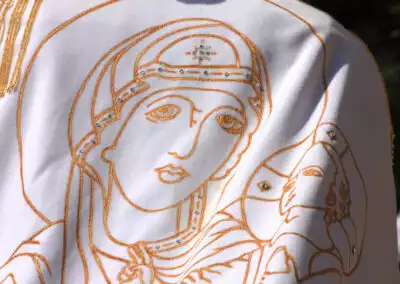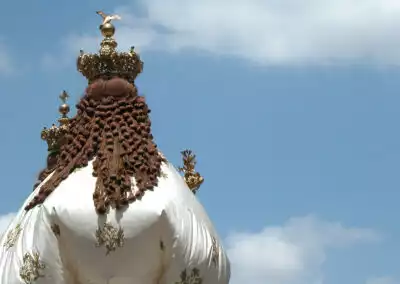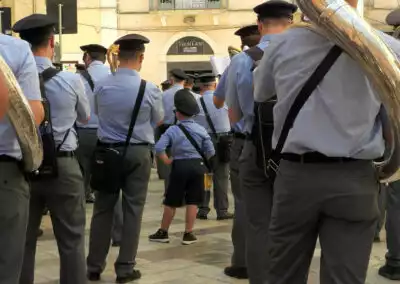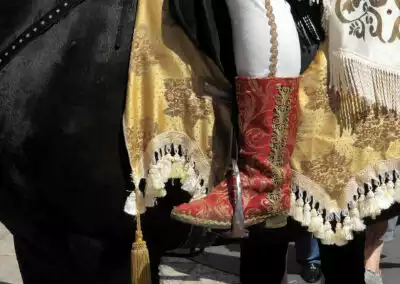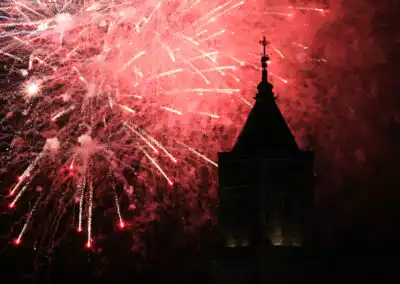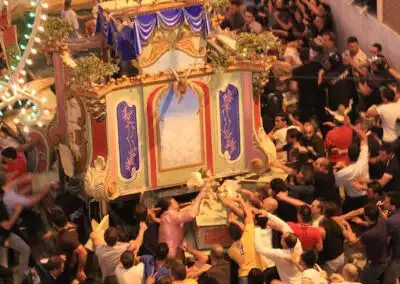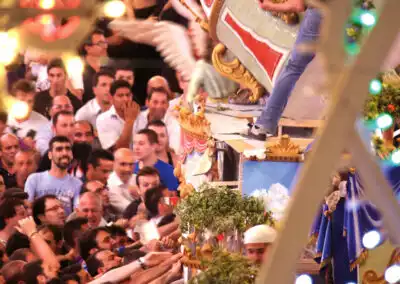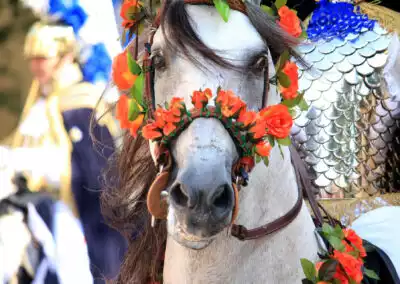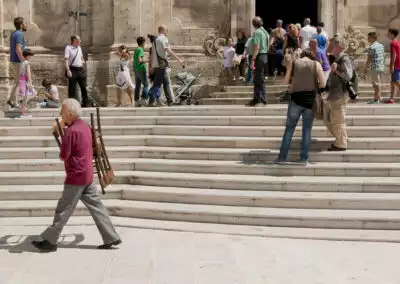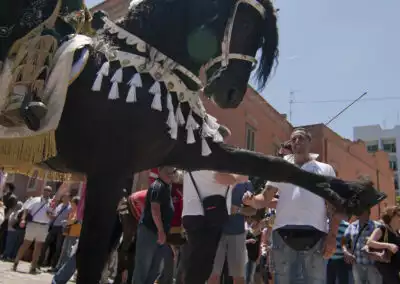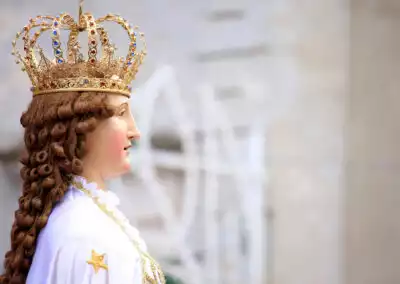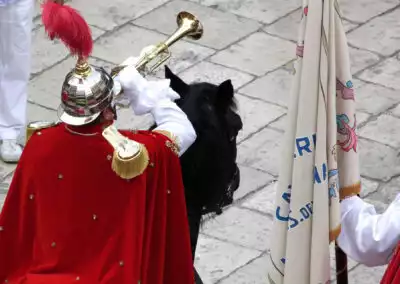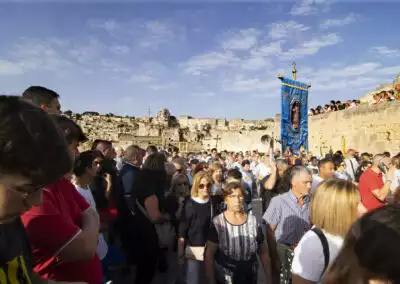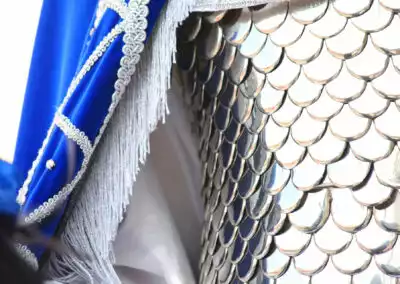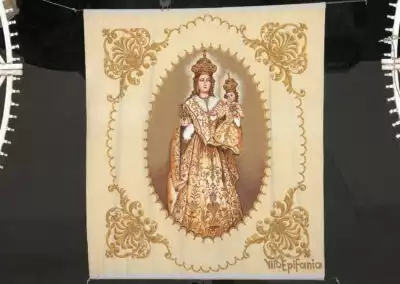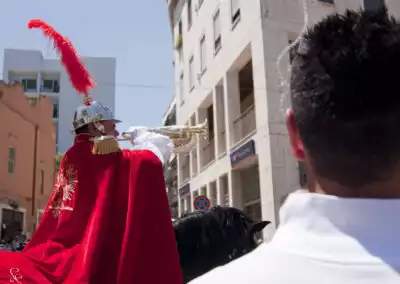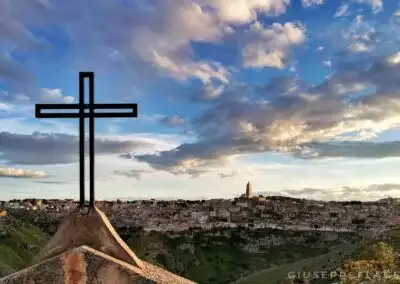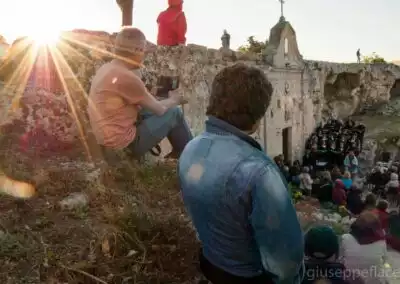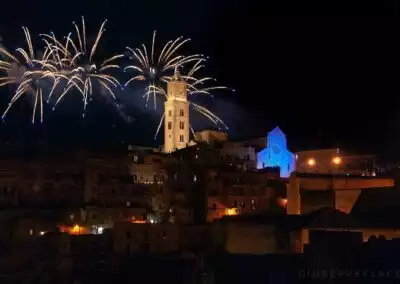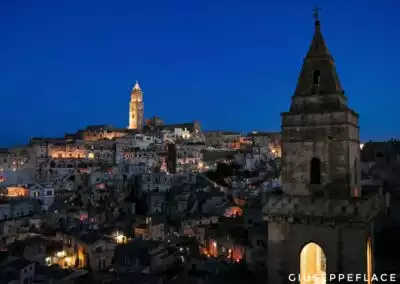Matera still keeps intact its ancient religious and popular traditions, although some of them need reinvigorating because in recent times they have lost some of their impact. Even the typical cuisine is closely linked to certain religious ceremonies. The deep religiosity of the population of Matera is historically substantiated by the extraordinary number of stone-built and rupestrian churches in the city and the surrounding area, many of which were founded by noble citizens to strengthen the faith and devotion of the people. Very close to people’s heart, in addition to the Carnival, the rites of Holy Week and Christmas, are the many festivals in honour of Virgin Mary, starting with the Festival of Bruna, patroness of the city, which earned the city the title of Matera Civitas Mariae.
Insights
Festival of the Bruna
Festival of Saint Eustace
Matera Sacra
Via Crucis in the Sassi of Matera
Good Friday Procession
Procession Cristo La Selva
Santa Venerdia
Living Nativity
Festival of Our Lady of the Virgins
Festival of Our Lady of Picciano
Festival of Our Lady of the Palomba
Festival of Our Lady of the Murgia
Sagra della Fedda Rossa e della Crapiata
READ THE WHOLE TEXT
Fact sheet – The legend of the Bruna
Fact sheet- The legend of Saint Eustace
Fact sheet – The legend of Our Lady of Picciano
Fact sheet – The carnival
Fact sheet – The festival of San Salvatore
Festival of the Madonna della Bruna
The festival in honour of the Madonna della Bruna, protectress of the City, is among the most evocative and oldest patron saints’ festivals in Italy. The festivities take place on 2nd July, the day of the visit by the Blessed Virgin Mary to St. Elizabeth, which was introduced into the liturgical calendar on 28th April, 1386 by John of Jenstein, archbishop of Prague. The Supreme Pontiff Urban VI, who was bishop of Matera from 1365 to 1377, wanted to direct the devotion of the people of Matera towards the fresco of the Madonna della Bruna, venerated in the Cathedral in the form of an icon, with the festival of the visitation made official in the same year and quickly became popular thanks to the Jubilee of 1390. The festival begins at dawn with the “Procession of the Shepherds”. The procession crosses the ancient Sassi districts with the picture of the Madonna della Bruna amidst fireworks, together with the shepherds and their animals, once very numerous, up to the church of San Francesco da Paola, an ancient sanctuary now incorporated in the historical centre, where the holy mass takes place. Meanwhile, the trumpeter of the costume cavalcade joins the Knights of the Bruna on the Piazza Vittorio Veneto to honour their general. Then comes the procession of the clergy that accompanies the statue of the Madonna and Child escorted by the Knights up to the church of the Annunziata in the Piccianello district, from where in the evening the “Procession of the peasants” will be starting out in a triumphal float made of papier-mâché escorted by the Knights of the Bruna carrying the statue of the Madonna and Child. The festival reaches its climax once the wagon has deposed the statue of the Madonna in the Cathedral and heads towards the Piazza Vittorio Veneto to be destroyed by the assault of the cheering crowd. Everyone wants to take home a piece of the float blessed by the Madonna. The moment of the destruction of the float, which is reconstructed every year for the purpose, certainly represents the most alluring event of the entire celebration, for its anthropological significance as a rite of renewal, of generous dissipation of resources, of emotional unleashing, of the rare legalized affront of the emblems of power – aspects which hold great fascination in popular culture regardless of time and place. The festival ends with the characteristic fireworks that illuminate the Sassi and the Murgia.
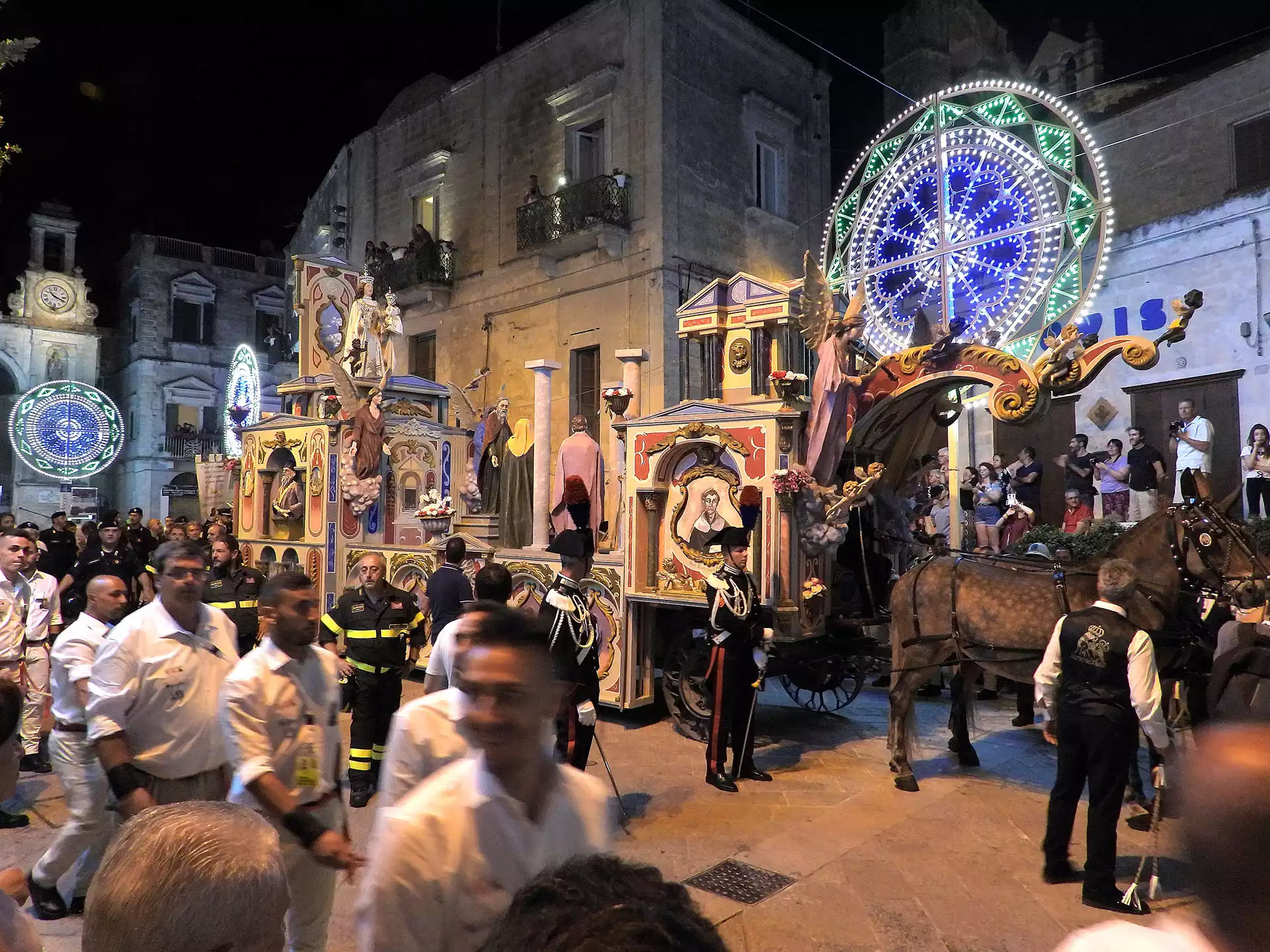
The legend of the Madonna della Bruna
Legend has it that a farmer returning from work in the fields came across a woman on the side of the road with a baby in her arms asking for a ride. As it was not customary at the time for a man to return to the city in a wagon with an unknown woman at his side, he decided to hide her in the wagon under a blanket and take her as far as the city gates. Arriving in the district of Piccianello, he stopped to drop off the woman and her child, but the Virgin Mary appeared to him, announcing her wish to take up permanent residence in the city, asking him to take this message to the Bishop. On being told, the Bishop went to the place of the apparition where he found the statue of the Virgin Mary and had it brought to the cathedral on a triumphal decorated float. The destruction of the foat has its origin in yet another legend. The citizens of Matera, in order to prevent the sacred image of the Virgin falling into the hands of the Saracens who besieged the city, hid it on the wagon to take it to the Cathedral. The Saracens intercepted the wagon and destroyed it but did not find the Virgin because the sacred image was already safe in the Cathedral.
Back to menù
Festival of Saint Eustace
The festival in honour of the patron saint Eustace, organized by the confraternity of the same name, is held on 20th May with the devotional offering to the Saint of typical produce, and again on 20th September, with greater solemnity, as it is preceded by the Novena from 11th to 19th September. During the Novena, children bearing the name Eustace are consecrated to the Saint and marriage vows are traditionally renewed by those who have completed their twenty-fifth and fiftieth anniversaries. On the twentieth day the religious procession with the statue of the Saint takes place in the streets of the historic centre among illuminations and musical bands. This is followed by fireworks with musical background in the park of the Tramontano castle. The date originally chosen for the commemorations of the patron saint was 20th May, in memory of the legendary liberation of the city from the Saracen siege, but later the festival was moved to 20th September, the day of the martyrdom, to make it possible for large numbers of farmers to participate. Following an ancient tradition, the chief magistrate of the city on behalf of the entire population, paid homage to the saint in the Norman Abbey of Saint Eustace of which today only the underground crypt remains. For the vesper he would bring as a gift a torch studded with silver coins, baskets of fruit, flowers, wine and cookies for the priests’ breakfast, between traditional dances and songs, and receive in return the offer of a loaf of bread, a barrel of wine, several ricotta cheeses, and a torch of wax.
The legend of Saint Eustace
aiEustace, together with his wife Theopista and his sons Agapitus and Theopistus, is a martyr of whom no reliable records are preserved. According to legend, which comes to us from Jacopo de Varagine during the 13th century, Eustace had been a general of Rome and servant of Trajan. He was a noble and wealthy man, feared by the barbarians who would flee the moment they heard his name. His original name was Placidus and his victories were enumerated in the form of a tale inscribed on the Trajan column. It is said that during a hunting excursion he encountered a deer with a cross between its antlers and was ordered by the voice of God to convert to the Christian faith. He and his entire family went to be baptized by the bishop of Rome and Placidus was named Eustace (which means fruitful, abundant in grain). On learning about his conversion, Trajan discharged him, forcing him to live the following fifteen years as a settler in a remote colony. He was found by Trajan’s soldiers and recalled to his homeland to re-take command of the army and confront the advancing barbarians. After the victory he received a laurel wreath as a prize and was miraculously reunited with his family. Trajan’s successor, Emperor Hadrian, was even less tolerant towards Christians. He had Eustace and his family thrown into a lions’ den, but the lions did not touch them. The family was then put into a brazen bull which was set on fire. The martyr is associated with Matera because according to another legend at the end of the 10th century it was he who freed the city from the siege by the Saracens and converted their commander to Christianity. It is said that Saint. Eustace appeared suddenly on the Murgia during the siege, defeated the Saracens but spared their commander, who entered the city to pay homage to him for having saved his life. He recognized him in a statue because of the ring on his finger, upon which he decided to convert to Christianity himself.
Back to menù
Mater Sacra
This is one of the most interesting events taking place in the city during Holy Week. Lights, sounds, colours and laser designs illuminate the Murgia and Gravina in a fascinating son et lumière spectacle that is enriched by a narrator. A religious event that offers the scenic and narrative representation of the crucifixion, deposition and resurrection of Christ. The show is staged in the evenings of Holy Week. For a good view of the event, go to Piazza San Pietro Caveoso and look towards the facing Murgia plateau.
Back to menù
Via Crucis in the Sassi of Matera
On Good Friday, groups of faithful gather in Piazza San Pietro Caveoso to take part in the emotionally charged Via Crucis in the Sassi of Matera. The fifteen stations of the Cross are bronze tiles, the work of the Italian sculptor and man of religion Ferdinando Amodei, better known as Father Tito. They were installed in 2004 at the behest of members of the Lions Club Host of Matera. The religious itinerary starts from the churchyard of San Pietro Caveoso and winds through the Malve and Casalnuovo districts until it reaches the Monterrone, the rocky spur in which the rupestrian churches of Madonna de Idris and San Giovanni in Monterrone perch. At each station of the Cross a different vista opens up that makes the event even more impressive.
Back to menù
Good Friday Procession
The Confraternity of the Servants of the Flagellated Jesus is in charge of organizing the Good Friday procession in the evening, which winds its way through the streets of the historic centre. The statue of Christ is accompanied by the brethren, who wear a white hooded sack and red mozzetta with the embroidered image of Ecce Homo, to the sound of the “tracca troc”, a traditional wooden musical instrument with iron rings. The sisters, in black robes with a white belt and scarf, carry the statue of Our Lady of Sorrows on their shoulders. The procession is attended by the Bishop, with the clergy and men of religion, as well as the faithful who are gathered along the way while the folk choir performs the traditional songs of Good Friday.
Back to menù
Lent Fridays during lent in Cristo la Gravinella
Every Friday during Lent, the traditional visit to the rock church of Cristo la Gravinella, in the San Pardo district, takes place. The Confraternity of the Servants of the Flagellated Jesus organizes in the church, which has frescoes dating from 1536, the Way of the Cross, the recitation of the rosary and the celebration of mass. In the past, many people from Matera used to make the pilgrimage to visit the church on the Fridays during Lent and on the day of the Holy Cross, to spend a day of leisure in the open air.
Back to menù
Procession of Cristo La Selva
On Good Friday groups of pilgrims gather at the first light of dawn in front of the church of Sant’Agnese, in the Agna district, to reach Cristo La Selva after a walk of a few kilometers along the hillside of the ravine. The rock church that holds the miraculous fresco of the Crucifix is open for worship only on this occasion. The faithful celebrate the Holy Mass and then board the buses provided by the municipal administration to get back to the city.
Back to menù
Santa Venerdia
In the Christian liturgy, the day of Jesus’ crucifixion is also called the “Day of Parasceve”. On that day, the liturgy is characterized by the adoration of the Holy Cross through the litanies and by the rite of consuming the Eucharistic bread consecrated the previous day. Ever since the Middle Ages, the sanctity of the day was translated into the cult of Santa Parasceve or Venerdia. The Saint was venerated in a church destroyed in the fifties during the works for the construction of the Serra Venerdì district, which bears her name.
Back to menù
Living Nativity
The living nativity is a spectacular event that is celebrated in the Sassi districts of Matera, picked by a number of film directors as the ideal location to evoke the holy places of Jesus’ life. About two hundred figures in costume enliven the alleys and lanes of the Sassi, along a route of about five kilometers in length. Along the route there are not only the actors of the “Gruppo Storico Romano”, who stage the Roman castrum, the camp, the school of gladiators, the senate, the domus and the dancers, but also various experts practicing ancient crafts, ordinary folk, shepherds and sellers of all kinds of goods. A narrator’s voice and highly evocative scenes accompany visitors to the Bethlehem cave set up in the Casalnuovo district of Sasso Caveoso.
Back to menù
Festival of Our Lady of the Virgins
The celebrations in honour of Our Lady of the Virgins nominated “Patroness of the Murgia territory”, take place on 31st May. Just as in ancient times, the faithful go on a pilgrimage to the church. They gather at Porta Pistola at the foot of the Civita and walk along a path that crosses the Gravina stream from the Sassi and then leads them to the church. Along the route one can make several stops to visit the rock churches of Madonna di Monte Verde, Madonna degli Angeli, Madonna dei Derelitti and the ancient church of Sant’Elia. After the religious rite the festivities continue with the procession around the church and fireworks. Until the fifties there was a tradition among the tradesmen to visit the church every Monday during the month of May, when the shops were shut, and on the last Sunday in May on which a procession was held. Some would honour the vows they had made to the Virgin for favors received by walking barefoot, fasting, crawling on their knees and licking the line of majolica tiles leading from the entrance of the church to the altar. Then they would stop in the caves next to the church to have lunch accompanied by traditional songs and dances.
Back to menù
The Legend of Our Lady of Picciano
VirginAccording to legend, the Virgin appeared to a shepherd looking for lost cattle in the Picciano woods. She requested a search for an antique statue that the faithful had hidden at the time of the iconoclastic struggle and to build a church on the site. The shepherd began to search and beg for donations in order to fulfill the Virgin’s request and since no one believed him, the Virgin made a second appearance, handing him a picture to take to the Bishop. When the Bishop saw the picture he recognized the Annunciation and believed the story of the shepherd. He hastened to the Mount of Picciano, excavated and brought back the statue that is carried in the procession, and built the church on the site of the discovery. Another story tells of a woodcutter who went into the woods of Picciano to cut an oak tree, saw blood flowing from the trunk of the tree at the first strokes of the axe after which the Virgin appeared to him asking for a church to be built on the spot. According to another legend, a shepherd from the Abruzzi, while looking for the oxen he had lost in the woods, saw a light on top of the mountain and went to the place where he found the animals kneeling in front of a tree in the presence of the Virgin among its branches. The Virgin asked him to collect funds from the faithful to build the church. Since no one gave him credence, she imprinted her image on his hand. The shepherd built the church with the donations he had collected, and the Madonna in return freed Matera and Abruzzo from famine. According to some scholars the cult of the Madonna of Picciano would have spread through nomadic shepherds from the province of Pescara, where there was an ancient abbey dedicated to Our Lady of Help, near a village called Picciano.
The legend of Our Lady of Picciano
According to legend, the Madonna appeared to a shepherd looking for lost cattle in the Picciano woods. She requested a search for an antique statue that the faithful had hidden at the time of the iconoclastic struggle and to build a church on the site. The shepherd began to search and beg for donations in order to fulfill the Virgin’s request and since no one believed him, the Madonna made a second appearance, handing him a picture to take to the Bishop. When the Bishop saw the picture he recognized the Annunciation and believed the story of the shepherd. He hastened to the Mount of Picciano, excavated and brought back the statue that is carried in the procession, and built the church on the site of the discovery. Another story tells of a woodcutter who went into the woods of Picciano to cut an oak tree, saw blood flowing from the trunk of the tree at the first strokes of the axe after which the Madonna appeared to him asking for a church to be built on the spot. According to another legend, a shepherd from the Abruzzi, while looking for the oxen he had lost in the woods, saw a light on top of the mountain and went to the place where he found the animals kneeling in front of a tree in the presence of the Madonna among its branches. The Madonna asked him to collect funds from the faithful to build the church. Since no one gave him credence, she imprinted her image on his hand. The shepherd built the church with the donations he had collected, and the Madonna in return freed Matera and Abruzzo from famine. According to some scholars the cult of the Madonna of Picciano would have spread through nomadic shepherds from the province of Pescara, where there was an ancient abbey dedicated to Santa Maria del Soccorso, near a village called Picciano.
Back to menù
Festival of Our Lady of the Palomba
The church of Our Lady of the Palomba is a gathering of pilgrims on 8th September, day of the Nativity of the Blessed Virgin Mary. On that day, according to traditional custom, “the nuns of the Annunziata” went out praying into the streets of the Sassi and repeated: “Go to the Palomba – the baby Mary is born”. Object of worship is the medieval fresco of the Virgin, venerated in the form of an Hodegetria icon, to which the popular tradition attributes many physical healings, venerated especially by people suffering from hernia. For the celebrations in honour of the Virgin, a solemn mass is celebrated and pilgrims have the opportunity to visit the caves adjacent to the church to admire the sacred rock paintings. The church is open for worship every Sunday of the year as well as for special occasions such as weddings, baptisms, confirmations and wedding anniversaries.
Back to menù
Festival of Our Lady of the Murgia
The Festival of Our Lady of the Murgia is very close to the hearts of the inhabitants of Montescaglioso, although the rock church belongs to the municipality of Matera. In the past the church was known by the name of Madonna della Palomba, as it was embedded into the troglodyte dwelling of the same name that belonged to the Gattini counts. Today, it is also known as Madonna dell’Aloja and Madonna della Loe. The festivities take place on the first Sunday of May. Groups of pilgrims led by the ecclesiastical community of Montescaglioso and the Madonna della Murgia Committee of Montescaglioso gather early in the morning in Piazza Roma to walk to the former railway station. Here other pilgrims join the procession and continue in the direction of the rock church where Holy Mass is celebrated. At the end of the religious function the effigies of the Virgin are carried in procession on the plateau above the church. Pilgrims typically eat lunch and visit the many other rock churches in the area.
Back to menù
Sagra della Fedda Rossa e della Crapiata
The tradition of the Sagra della Fedda Rossa at Borgo La Martella has turned into a rural festival which takes place once a year on 31st July. Inhabitants are invited by the town crier to assemble for the traditional festival in Piazza Montegrappa, where between musical performances and the noise and bustle of the stalls, one can taste the famous Fedda Rossa, the typical bruschetta prepared with stale Matera bread cooked on the grill and seasoned with oil, salt and oregano accompanied by Primitivo wine.
The following day, also at Borgo La Martella, the tradition of the Sagra della Crapiata attracts visitors, for a soup of legumes that in days gone by was prepared in the neighbourhoods of the Sassi as a thanksgiving for the harvest and to celebrate the end of working in the fields. In fact, on 15th August, during the feast of the Assumption , the leases for land to be used for grazing and agriculture and the contracts for rental of houses were renewed, and the farmers hired the farm labourers to organize the work in the fields for the next year. On 1st August all the farmers celebrated the harvest by offering their legumes to their community. Everything was boiled in a huge pot with just water and salt, respecting the different cooking times of the various legumes. It was a way to promote the sale of products through tasting and celebrating with a good glass of Primitivo wine.
Back to menù
The Carnival
On 17 January, the feast of St. Anthony the Great, groups of improvised masks gathered in the Sasso Barisano, near the little church of St. Anthony the Great to commence the Carnival celebrations. Men dressed as women and vice versa, or as kings and queens with a paper crown on their heads. In the period of Carnival the farmers slaughtered a pig and after having selected the different parts of the meat for making sausages, hams and brawn, they knew that in the following days they might be receiving surprise visits, in the middle of the night, from relatives and friends, as a carnival prank. These cheerful impromptu gatherings were called “matinate”. Someone would bring a typical instrument called cupa-cupa, a guitar and an accordion and sing the praises of the hosts – and then eat and drink until the early morning hours. The feast ended with the host expressing his expectation to enjoy further celebrations over the following days at the homes of those he had hosted. On the Sundays following Carnival, each family would improvise dances during which they would break the pignata, an earthenware pot full of sausage and cheese. Goats were killed and the culinary offerings also included ricotta calzone and carnival fritters, the sweet fried dough that was typical for these festivities. It is a shame this particular tradition has fallen into oblivion. What remains today of the Carnival are the masked parties and the “Carnival on horseback”, which is promoted by various local associations. Masked horseback riders, majorettes, stilt walkers, fire eaters, musicians and masked groups parade through the streets of the city entertaining the young and the old.
Back to menù
The festival of San Salvatore
init.,village The rites related to the fertility of the earth in honour of the patron saint, between history and legend, are an ancient tradition that has remained more or less intact in many places throughout Southern Italy. In Basilicata there are May festivals in Accettura, Oliveto Lucano, Castelmezzano and Pietrapertosa, the Abete (Fir Tree) festival in Rotonda, the Pitu festival in Viggianello, the Antenna festival in Castelsaraceno, the Pita(Beach tree or Turkey oak) festival in Terranova del Pollino, all with ancient traditions featuring dances, popular songs and dances around a tree or pole, to symbolically celebrate the fertility of nature, the abundance of the harvest, the victory of good forces over evil. These celebrations have a sacred and a profane flavor, with magical and religious connotations, usually ending with the climbing of the Maypole. In the context of these ancient rituals associated with the relationship between man and earth, we should not forget the traditional dance of the banner in honour of God the Saviour which is held on the second Sunday of September in the village of Timmari. This ancient rite, which was in danger of disappearing forever, has been revived thanks to the commitment of the village elders known as “i Tammarali”, who after having carefully preserved the banner, organize the festival at their own expense to safeguard the tradition and pass on to the young generation, a difficult and demanding dance. The dance consists of holding a several metre high banner between the teeth and balancing it to the rhythm of the drums. This banner is topped by the ancient flag of the Brotherhood of the Settlers of Timmari, bearing the image of God the Saviour. The festival begins on Saturday with the religious function in the sanctuary of San Salvatore and continues on Sunday with the procession, the dance of the banner and the climbing pole, set up for the occasion with cold cuts and cheeses, to be taken by storm by groups of youngsters. In ancient times the dance was done with the American agave, a plant originating from Central America which in dialect was called, with evident phallic allusion, “stannord/stendardo”. The plant, when it reaches full maturity, sacrifices itself in the reproductive act, blooming with a wonderful stem which can reach the height of ten metres, and then dies. The dance of the “stendardo” was a celebration of the vegetative rebirth, symbol of the reawakening of the forces of nature, so that after the winter it can awaken luxuriant and fertile, with the promise of bearing fruit.
Back to menù

